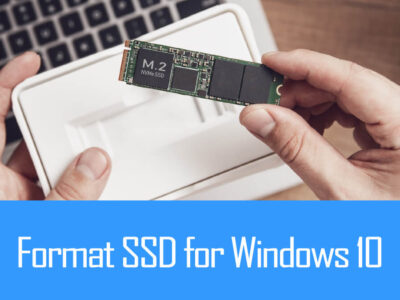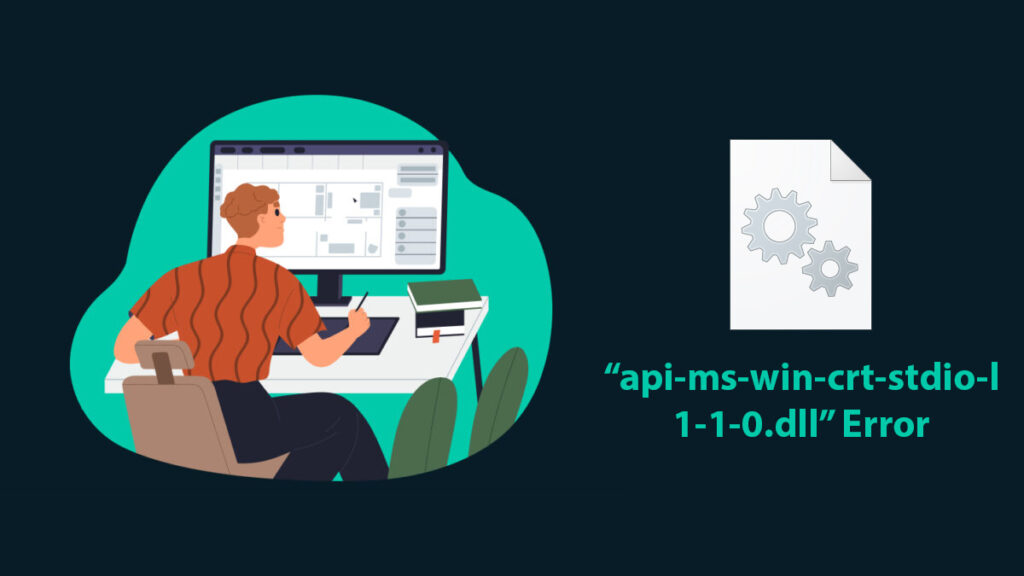
How to Fix the “api-ms-win-crt-stdio-l1-1-0.dll is Missing” Error?
The “api-ms-win-crt-stdio-l1-1-0.dll is missing” error is a common issue that Windows users encounter when trying to run certain applications or programs. This error message indicates that a crucial system file required for the operation of these programs is either not present or has become corrupted.
Fortunately, there are several methods you can apply to resolve this issue and get your applications up and running smoothly. In this comprehensive guide, we will explore various methods to fix the “api-ms-win-crt-stdio-l1-1-0.dll is missing” errors on Windows.
From using basic steps to using third-party tools, we will use all the possible ways to fix the issue.
Table of Contents
Understanding DLL Files and Common Errors
Before delving into the solutions, it’s important to have a fundamental understanding of DLL (Dynamic-Link Library) files. DLL files are shared libraries in the Windows operating system, critical for the proper execution of software applications. They contain a set of functions and data that can be used by multiple programs, promoting code reusability and efficient memory usage.
When encountering the “api-ms-win-crt-stdio-l1-1-0.dll is missing” error, it signifies that a specific DLL file related to the C Runtime Library is not accessible. This can be attributed to a variety of reasons, including accidental deletion, corruption due to malicious software, or an incomplete installation.
Fix the “api-ms-win-crt-stdio-l1-1-0.dll is Missing” Error

Now let’s fix the “api-ms-win-crt-stdio-l1-1-0.dll is Missing” error.
Method 1: Manual Installation of api-ms-win-crt-stdio-l1-1-0.dll
One of the most direct ways to address this issue is by manually downloading and installing the required DLL file. Follow these steps:
1. You are going to download the file of api-ms-win-crt-stdio-|1-1-0.dll manually using this direct link. The link will provide you to
2. Select the version that matches your system architecture (32-bit or 64-bit) and click on Download.
| api-ms-win-crt-stdio-l1-1-0.dll (32-Bit).zip | api-ms-win-crt-stdio-l1-1-0.dll (64-Bit).zip |
| 14.29 KB | 4.91 KB |
3. Download the file and save it to a location on your computer where you can easily locate it.
4. Depending on your system architecture, you’ll download the DLL file and place it in the appropriate directory:
– For 32-bit systems, move it to: C:\Windows\System32
– For 64-bit systems, move it to: C:\Windows\SysWOW64
5. After placing the file in the correct directory, restart your computer to allow the changes to take effect.
Method 2: Utilize an Error Fixing Tool
When facing the vexing “api-ms-win-crt-stdio-l1-1-0.dll missing” error, it’s essential to have a reliable approach to rectify the issue promptly. One of the most efficient methods involves employing an error-fixing tool.
Error fixing tools are specialized programs designed to automatically identify and repair issues related to DLL files.
These tools streamline the process and can be particularly useful for users who may not be comfortable manually handling system files. Here’s how you can use an error-fixing tool:
How an Error Fixing Tool Works?
An error-fixing tool operates by scanning your system for inconsistencies, corrupted files, and missing DLLs. Once it identifies the problematic components, it takes the necessary steps to rectify them, often by automatically downloading and replacing the damaged or missing files.
These tools are equipped with sophisticated algorithms that enable them to pinpoint and address a multitude of system errors, including the notorious “api-ms-win-crt-stdio-l1-1-0.dll missing” issue.
Choosing the Right Error Fixing Tool
Selecting the appropriate error-fixing tool is paramount to a successful resolution. It’s advisable to opt for a reputable and well-established tool that has a track record of effectively addressing DLL-related errors.
Popular error-fixing tools are often developed by trusted software companies and are backed by positive user reviews and ratings.
Using the Error Fixing Tool
1. Download and Install: Begin by downloading the error-fixing tool from the internet. Once downloaded, run the installer and follow the on-screen instructions to complete the installation process.
2. Launch the Tool: After installation, launch the error-fixing tool. It will typically have an intuitive user interface that guides you through the steps.
3. Initiate the Scan: The tool will prompt you to initiate a system scan. This scan will comprehensively analyze your system for any DLL-related issues, including the “api-ms-win-crt-stdio-l1-1-0.dll missing” error.
4. Review the Results: Once the scan is complete, the tool will present you with a detailed report of its findings. This report will specify which files or components are causing the error.
5. Execute the Repair: With the results in hand, you can proceed to execute the repair process. The tool will automatically download and replace any damaged or missing DLL files, effectively resolving the error.
6. Restart Your Computer: After the repair process is complete, it’s advisable to restart your computer to ensure that the changes take effect.
Method 3: Reinstall your Microsoft Visual C++
The “api-ms-win-crt-stdio-l1-1-0.dll missing” error often arises due to issues with the Microsoft Visual C++ Redistributable Package, a crucial component for running various applications on Windows. Reinstalling this package can effectively resolve the error and restore seamless functionality to your system.
Errors related to “api-ms-win-crt-stdio-l1-1-0.dll missing” can occur if the installed version of Microsoft Visual C++ is corrupted, outdated, or improperly configured. Reinstalling this package is a practical step to ensure that the required DLLs are in place and functioning correctly.
1. Open the Control Panel from the Start menu.
2. In Programs, find the Microsoft Visual C++ Redistributable Packages.
3. Right-click on it and select the Uninstall option.
4. Now you will see two options; uninstall the application or repair it. Select the Repair option and the application will be reinstalled and any error will be fixed.
By reinstalling the Microsoft Visual C++ Redistributable Package, you’re effectively addressing the root cause of the “api-ms-win-crt-stdio-l1-1-0.dll missing” error, ultimately ensuring a smoother and more stable computing experience.
Method 4: Install the latest version of Microsoft Visual C++ Redistributable Package
The Microsoft Visual C++ Redistributable Package includes essential components for running C++ applications. Sometimes, issues with this package can lead to DLL-related errors, and moments are there when the application can’t be installed properly.
Using the Repair option also won’t fix the issue. Instead, you are recommended to install the latest version of Microsoft Visual C++ on your Windows. Follow these steps to address the problem:
1. Open the Control Panel from the Start menu.
2. Navigate to the Programs or Programs and Features.
3. Look for any versions of the Microsoft Visual C++ Redistributable Package installed on your system.
4. Check the version of the package. If it is an older version, consider uninstalling it.
5. Now download the latest version of the Visual C++ Redistributable Package.
6. Install the downloaded package on your PC by following the installation prompts.
7. Once the installation is complete, restart your computer.
While this method might look simple, you will find this one the most effective one. You are recommended to use this method and check for the result. If not fixed then you should check for the application that you want to run and check the compatibility with Microsoft Visual C++.
Instead of installing all the versions, try to install the exact compatible version of Microsoft Visual C++.
Method 5: Reinstall the Problematic Program
If the error occurs when trying to run a specific program, it’s possible that the program itself may be the source of the issue. Reinstalling the program can sometimes resolve DLL-related errors. Follow these steps:
1. Navigate to the Control Panel on your computer.
2. Locate the problematic program in the list of installed applications.
3. Uninstall the program from your system.
Restart your system and check again for the issue. If the error still presists then you will need to check for any damaged or corrupt files as there is no issue present in your Microsoft Visual C++ or program running on your system.
Method 6: System File Checker (SFC) Scan
The System File Checker is a built-in Windows utility that can help identify and repair corrupted or missing system files, including DLL files.
To perform an SFC (System File Checker) scan on Windows, follow these steps:
1. Press the Windows and type “cmd”.
2. Right-click on Command Prompt and select Run as administrator.
3. In the Command Prompt window, type “sfc /scannow” and press Enter.
4. The scan will start, and it may take some time to complete.
5. Once done, restart your computer.
The SFC scan checks and repairs corrupted system files, helping to stabilize your Windows system.
Method 7: Use a Registry Cleaner
If you’re experiencing persistent issues related to DLL files, consider using a reliable registry cleaner.
Registry cleaners are software programs designed to scan, clean, and optimize the Windows registry, which contains crucial information about system settings and configurations.
Sometimes, issues within the registry can lead to DLL-related errors. Here’s how you can use a registry cleaner:
1. Begin by downloading and installing a reputable registry cleaner tool compatible with your Windows OS.
2. Once installed, run the program. It will automatically initiate a comprehensive scan of your system’s registry.
3. The utility will identify and fix problematic areas, ensuring smoother system performance.
4. Be sure to regularly use the registry cleaner to maintain the health and integrity of your Windows registry.
By employing a registry cleaner, you can effectively address DLL-related issues and optimize your system’s overall performance.
Frequently Asked Questions (FAQ)
Q: What is the latest version of api-ms-win-crt-stdio-l1-1-0.dll file?
A: As of the latest available information, version 10.0.18362.1 is the most recent version of api-ms-win-crt-stdio-l1-1-0.dll available for download.
Q: Where should I place api-ms-win-crt-stdio-l1-1-0.dll files in Windows 10?
A: The api-ms-win-crt-stdio-l1-1-0.dll file should be located in the Windows system folder. For 32-bit systems, this is typically C:\Windows\System32, and for 64-bit systems, it is C:\Windows\SysWOW64.
Q: What is the easiest way to install a missing api-ms-win-crt-stdio-l1-1-0.dll?
A: The easiest method to fix this issue is by using a DLL error-fixing tool. These tools are designed to automatically repair corrupted or missing DLL files in Windows folders.
In conclusion, encountering the “api-ms-win-crt-stdio-l1-1-0.dll is missing” error can be frustrating, but with the right approach, it can be effectively resolved.
By following the methods outlined in this guide, you can address the issue and ensure your applications run smoothly. Always exercise caution when working with system files and consider creating backups before making any significant changes to your system.

